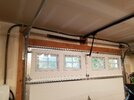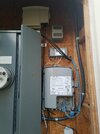kishkaru
Member
That calculator is horribly broken. Looks like it's hard-coded to use 100% rating ampacity rating until it gets to 132-140F correction factor, where it starts lowering ampacity in the calculated output. Check the JS console for debugging output if you're technical.So found this handy calculator, and loaded in some sample values. Is it wrong? Read the fine print, and it references the 60C rating of NM-B cable.
Ampacity Calculator
The purpose of this calculator is to determine the ampacity of conductors in conduit, cable, or directly buried. All calculations are based on the National Electrical Code®.www.cerrowire.com
View attachment 666679
*The calculated ampacity value is the minimum of: the corrected and adjusted ampacity; the equipment temperature limitation default values as described in NEC® 110.14(C)(1); or the cable type temperature limitation. The initial input values are also shown for verification, and they will be emailed along with the calculated ampacity if the email option is chosen. The insulation temperature rating is the rated temperature of the insulation surrounding the conductor metal, and the termination temperature rating is based on the default values shown in NEC 110.14(C)(1). If a cable wiring method was chosen, the temperature limit is 60℃ for NM-B and UF-B, and it is 75℃ for SER, SEU and MC cable.
NM-B wire is not even allowed to be used at that high of a temp (132-140F), so the calculations doesn't even make any sense. A halfway decent calculator should drop the ampacity to 0A if its out of range for the conductor type (like in the calculator below).
Also check the fine print on the page:
... Ampacities are based on the 2017 NEC and do not reflect any temperature correction or ampacity adjustments that may be required. Please consult a qualified electrician or professional engineer to determine the appropriate values for your specific application. ...
---
reference tables for the calculator above.
Namely: default ampacities + temp correction factors = calculator output.
Last edited:




